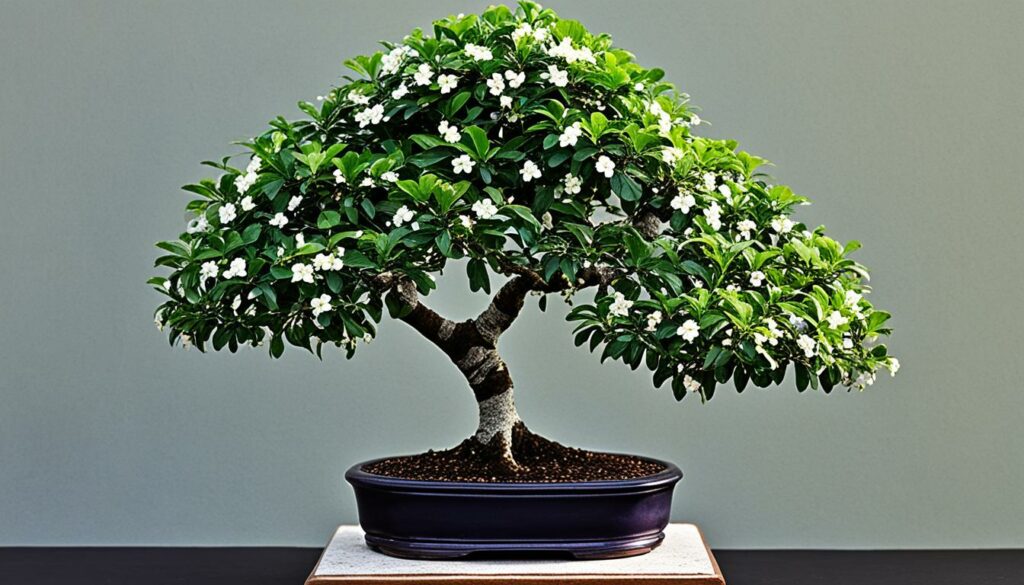As a bonsai enthusiast, you are always searching for new and distinctive species to add to your collection. One such species that you won’t want to miss is the Jabuticaba bonsai, also known as Brazilian grape tree, which is gaining popularity due to its dual appeal as an ornamental bonsai and a fruiting bonsai.
Originating from Brazil, the Jabuticaba bonsai is unique due to its the fruit that grows directly on its trunk and branches. Its delicate foliage and intriguing trunk make it an aesthetically pleasing addition to any indoor or outdoor bonsai collection.
Key Takeaways:
- The Jabuticaba bonsai is a unique species that originates from Brazil.
- It is known for its fruit which grows directly on its trunk and branches.
- Jabuticaba bonsai has delicate foliage and intriguing trunk, and it is an aesthetically pleasing addition to any indoor or outdoor bonsai collection.
- The Jabuticaba bonsai is becoming increasingly popular among bonsai enthusiasts.
- In addition to its ornamental appeal, the Jabuticaba fruit is also delicious and has several health benefits.
The Origins of Jabuticaba Bonsai
The Jabuticaba bonsai tree species originates from Brazil, where it can be found growing in the wild, particularly in the region around Minas Gerais. In Brazil, the tree is not only highly valued for its ornamental beauty but also for its fruit, which is widely consumed.
The tree’s cultural significance in Brazil is reflected in the number of names it has across the country, ranging from Jabuticaba to Guaperu, and Sabara. Its popularity as a bonsai tree has spread well beyond its native country and has become a staple in the bonsai communities around the world.
To cultivate a Jabuticaba bonsai, cultivators prune the tree’s roots, trunk, and branches. By keeping the tree small, the fruit production increases and the tree remains easy to maintain. A well-maintained Jabuticaba bonsai can be incredibly decorative, beloved for its ornamental value and its ability to produce tasty fruit year-round.
With the rise of popularity, Jabuticaba bonsai cultivation techniques and methods have evolved over time, making it a fascinating subject for bonsai enthusiasts.
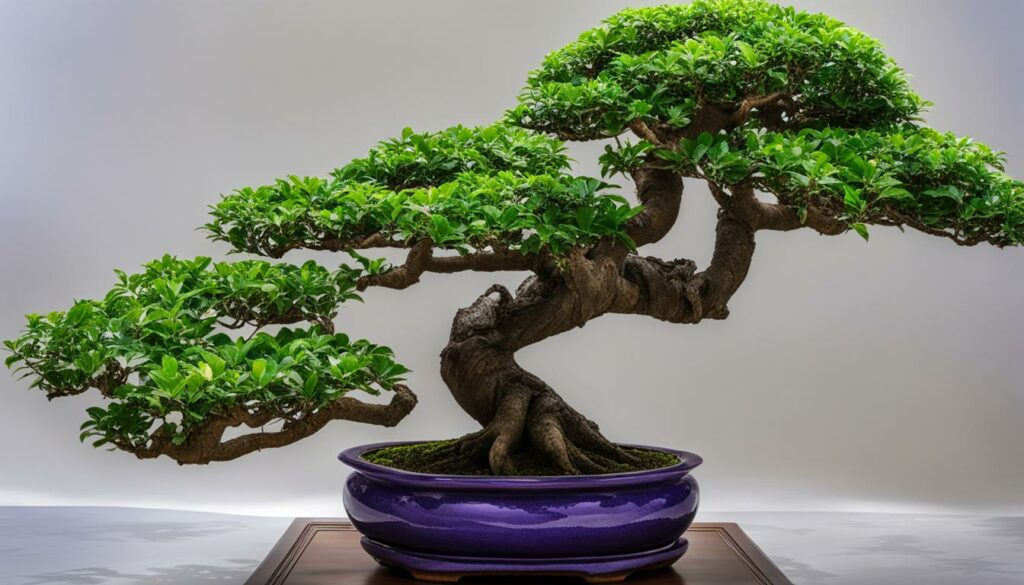
Characteristics of the Brazilian Grape Tree
The Brazilian Grape Tree, also known as Jabuticaba, is a fascinating bonsai tree species sought after worldwide for its striking features and edible fruits. One of the most intriguing characteristics of this tree is the phenomenon of “fruit cauliflory,” which refers to the growth of fruit directly on its trunk and branches. This feature not only makes it a unique addition to any bonsai collection, but also a source of delicious berries.
The foliage of the Brazilian Grape Tree is dense and evergreen, with small leaves that are a vibrant shade of green. The trunk is notably smooth, with a light gray bark that peels off in thin layers. The tree’s branches tend to grow in a twisting pattern, adding to its overall aesthetic appeal and sculptural quality.
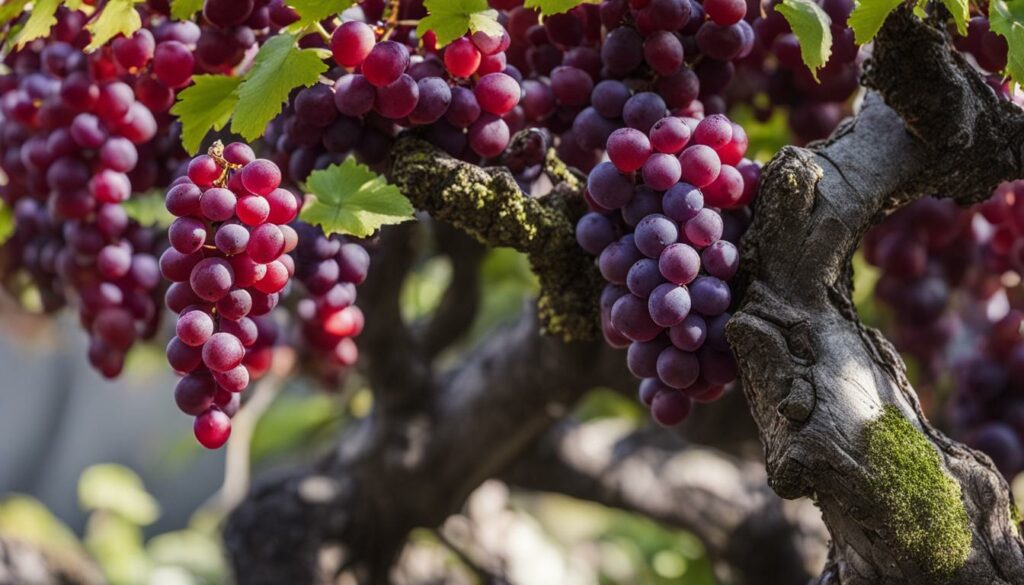
There are several varieties of Jabuticaba bonsai trees, with some producing larger and sweeter fruits than others. The fruits themselves are small and round, with a thick skin and a white, juicy pulp inside. They have a unique flavor profile that is sweet with a slightly tart finish, making them a versatile ingredient in many desserts and beverages.
Given its fascinating features and fruiting potential, the Brazilian Grape Tree is a popular choice for bonsai enthusiasts looking for a unique and rewarding addition to their collection.
Cultivating Jabuticaba as a Bonsai
If you’ve decided to cultivate a Jabuticaba bonsai, understanding its specific growing conditions is crucial. The Brazilian grape tree originates from the tropical regions of Brazil, where it thrives in warm temperatures and high humidity.
The ideal soil for Jabuticaba bonsai should be well-draining and acidic with a pH level between 4 to 6.5. You can use a mix of peat moss, coarse sand, and perlite to create the perfect soil mix. It’s important to ensure your bonsai receives regular watering to maintain moisture in the soil.
To promote the growth of edible fruits, proper pruning techniques are crucial. Pruning should be carried out during the dormant season. You can remove any unwanted branches or shoots and shape the tree using wiring techniques.
The shaping methods used for Jabuticaba bonsai are unique. Instead of creating the traditional tree-shaped bonsai, Jabuticaba bonsai is trained to grow low and wide, replicating the natural growth habits of the Brazilian grape tree. You can create horizontal branching structures to stimulate the development of fruits directly on the branches’ surface.
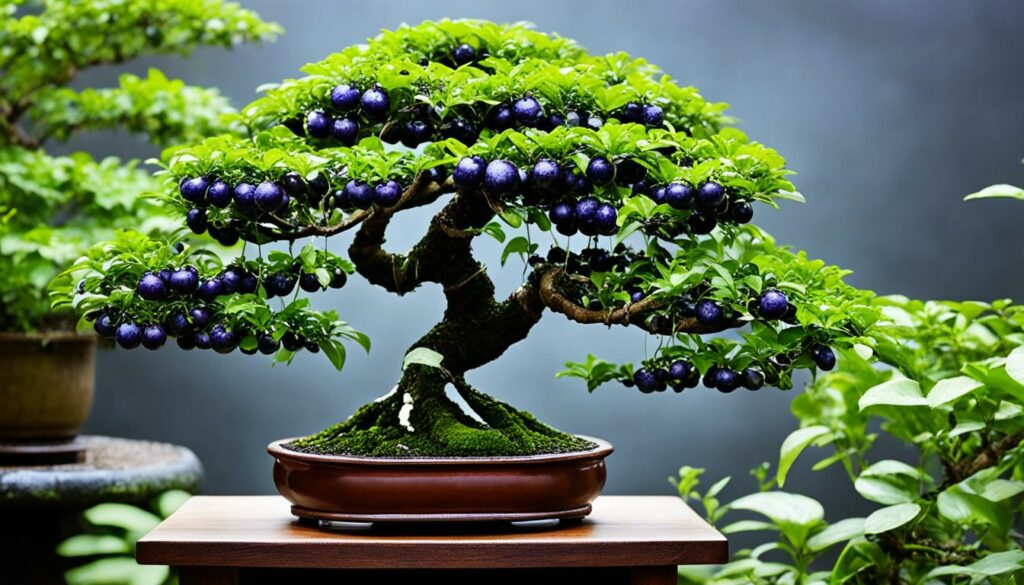
When the Jabuticaba bonsai matures to around 3-4 years, it will start to produce small white flowers that will eventually grow into delicious berries. The fruit can be harvested once it’s plump and dark purple. The Jabuticaba berries are rich in antioxidants and can be consumed fresh, used in desserts, drinks, and jams.
Cultivating Jabuticaba as a bonsai is not only a rewarding hobby but also a unique way to enjoy the beauty of a Brazilian grape tree in miniature form.
Ornamental Charm of Jabuticaba Bonsai
When it comes to bonsai trees, the Jabuticaba bonsai tree is a true marvel. Its unique features, such as the delicate flowers, lush foliage, and fruiting characteristics, make it a stunning addition to any indoor or outdoor bonsai collection. One of the most coveted features of this tree is its ability to bear fruit directly on its trunk and branches, making it a fruiting bonsai unlike any other.
To showcase the beauty of Jabuticaba bonsai in your own space, provide it with a bright, partially shaded location, and ample humidity. This tree requires minimal pruning to maintain its desired form, and will naturally produce fruit during the growing season.
The Jabuticaba bonsai’s distinctive and ornamental appearance makes it a highly sought-after addition to any bonsai collection. It is particularly well-suited to high-end garden design, where it can serve as the centerpiece of a visually stunning and unique landscape.
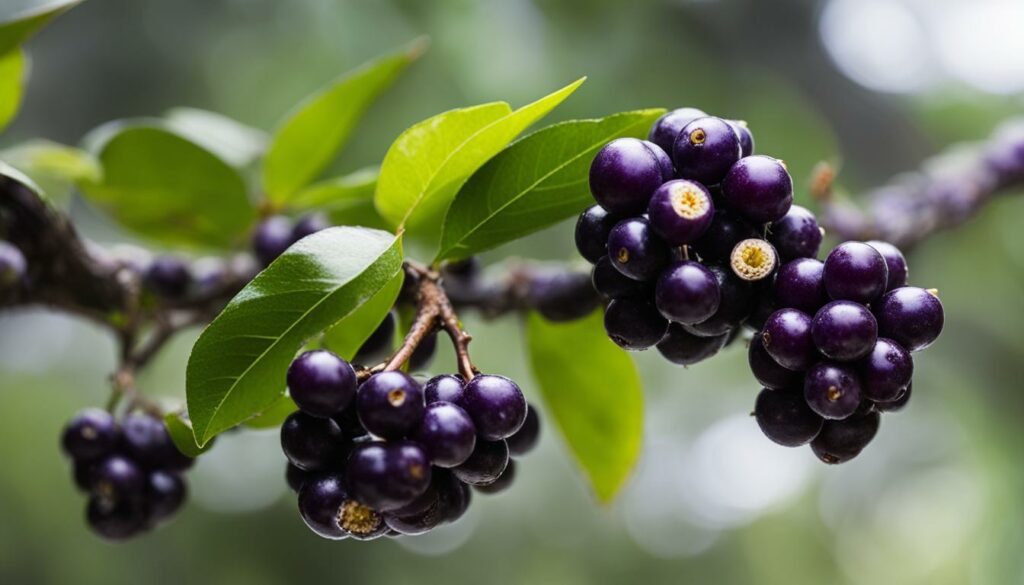
Its fruiting characteristics also make it a preferable choice among gardeners, fruit lovers, and bonsai enthusiasts alike. With their unique flavor profile and culinary uses, the fruits of the Brazilian Grape Tree, also known as the Jabuticaba, add a delectable touch to both sweet and savory culinary creations.
The Culinary Delights of Jabuticaba Fruits
If you thought the Jabuticaba tree was only good for its beauty, think again. These trees produce a delightful fruit that is a must-try for any fruit lover. Jabuticaba fruits have a unique flavor profile that is difficult to compare to other fruits. When ripe, they have a sweet, grape-like flavor with a hint of spiciness that lingers in your mouth.
But the flavor isn’t the only thing that makes Jabuticaba fruits special. They’re also packed with nutritional benefits. These small, dark-colored fruits contain high levels of antioxidants, which help protect your body from harmful free radicals. They’re also rich in vitamin C, which boosts your immune system and promotes healthy skin and hair.
Best of all, you can enjoy Jabuticaba fruits in a variety of ways. Some people eat them raw, while others use them in jams, jellies, and other sweet treats. You can also use the fruit to make a delicious, tangy sauce to accompany savory dishes like grilled meats and vegetables.
“The Jabuticaba fruit has a unique flavor that is both sweet and spicy, making it perfect for a variety of culinary creations.”
If you’re looking for a new and exciting culinary adventure, look no further than the Jabuticaba fruit and the Brazilian grape tree, a fruiting bonsai tree that produces these delectable fruits. Growing your own fruiting bonsai tree is not only a rewarding experience but also offers an array of culinary possibilities.
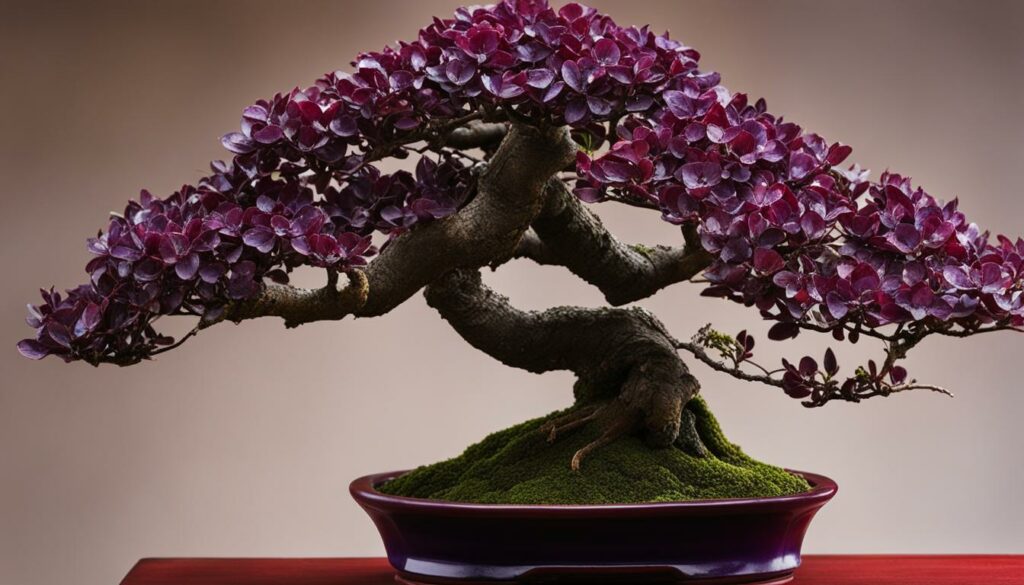
Conclusion
You’ve learned about the captivating world of Jabuticaba bonsai tree species. Its unique qualities and charm make it a desirable addition to any bonsai collection. Not only is it an ornamental tree, but it is also a fruiting bonsai, providing delicious berries for culinary use and health benefits. Consider exploring the world of Jabuticaba bonsai and discover all the wonders this tree species has to offer. Start with cultivating Jabuticaba as a bonsai tree and showcase its beauty in your indoor or outdoor space.
FAQ
What is a Jabuticaba bonsai tree?
A Jabuticaba bonsai tree is a miniature version of the Brazilian Grape Tree, scientifically known as Plinia cauliflora. It is a unique bonsai species that is known for its striking appearance and ability to bear fruit directly on its trunk and branches.
Where does the Jabuticaba bonsai tree originate from?
The Jabuticaba bonsai tree is native to Brazil, specifically the Atlantic Forest region. It has significant cultural and culinary importance in Brazil, where its fruits are enjoyed fresh, turned into juices, wines, and even liqueurs.
What are the characteristics of the Brazilian Grape Tree?
The Brazilian Grape Tree, or Jabuticaba, is known for its small, glossy leaves, intricate branching patterns, and unique growth habit of fruiting directly on the trunk and branches. Its bark can range from smooth to rough, adding to its visual appeal as a bonsai tree.
How do you cultivate Jabuticaba as a bonsai tree?
Cultivating Jabuticaba as a bonsai tree requires providing it with the right growing conditions, such as partial sun, well-draining soil, and consistent moisture. Regular pruning and wiring are also essential for shaping and maintaining its desired form.
Can Jabuticaba bonsai trees bear edible fruit?
Yes, Jabuticaba bonsai trees can indeed bear small, grape-like fruits. While the quantity may be limited compared to a full-sized tree, they are still edible and often prized for their unique flavor and culinary uses.
What are the culinary uses of Jabuticaba fruits?
Jabuticaba fruits can be eaten fresh, used in desserts, turned into jellies or jams, and even used as a flavoring for drinks and liqueurs. They have a sweet, grape-like taste with a hint of tartness, making them a versatile ingredient in various culinary creations.
Can Jabuticaba bonsai trees be grown indoors?
While Jabuticaba bonsai trees prefer to be grown outdoors in a mild climate, they can be grown indoors if given proper care. Adequate sunlight, regular humidity, and suitable temperatures are important factors to consider when growing a Jabuticaba bonsai tree indoors.
